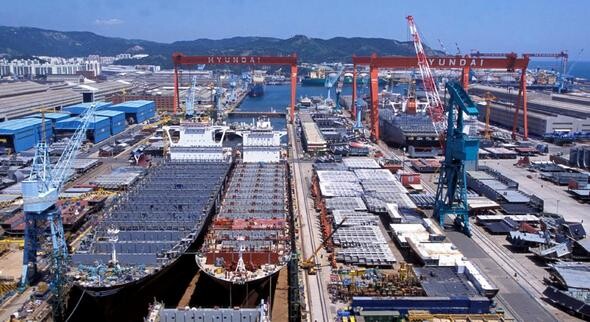hankyoreh
Links to other country sites 다른 나라 사이트 링크
The end of an era of dominance for S. Korea‘s big three shipbuilders

The global shipbuilding market once dominated by three major South Korean companies is undergoing rapid changes, with a Japanese competitor nudging its way into the top three as domestic builders struggle with a drought of new orders.
A list published on Mar. 20 by the British shipbuilding and shipping analysis organization Clarkson had the Hyundai Heavy Industries Group and Daewoo Shipbuilding and Marine Engineering Group continuing to rank first and second among shipbuilding groups with total orders of 8.83 million and 8.44 million comprehensive gross tonnage (CGT) for 204 and 139 vessels as of late February, respectively.
But the Samsung Heavy Industry Group dropped from third to fourth place behind Japan’s Imabari Shipbuilding Group with 5.08 million CGT and 101 vessels to the latter’s 6.96 million CGT and 244 vessels. Also ranking in the world’s top ten was the Japan Marine United Corporation.
Total orders represent all work commissioned from shipbuilding, providing an indicator of the company‘s standing in the industry.
In the past, Japan was considered the world’s top shipbuilding power. In the 2000s, it entered a period of decline amid high wages and increasingly inefficient production systems. South Korean competitors took full advantage, with the three largest accounting for 70% of global orders as recently as five years ago.
But from a market share of less than 10% ten years ago, Japan has steadily increased its orders after beefing up its industry with restructuring and taking advantage of the low yen. Today, China accounts for 40% of the world shipbuilding market, with South Korea and Japan each accounting for 30%. It‘s a signal of the end of an era for South Korea’s “big three” of Hyundai Heavy Industries, Daewoo Shipbuilding, and Samsung Heavy Industries.
“Last year, while South Korea’s shipbuilding companies were all over the map because of problems with offshore plants and other areas, Japanese companies were having a huge comeback and mopping up orders,” explained an industry source.
Unusually, Clarkson voiced explicit concern over the South Korean shipbuilding situation in its report, noting that the three top companies had produced deficits of over seven trillion won (US$6 billion) last year while another company, Sungdong Shipbuilding, was struggling with massive losses.
Chinese competitors are also poised to cut into the South Korean shipbuilders’ territory. As of late February, Yangzijiang Holdings ranked fifth in the world with 3.31 million CGT and 130 vessels; Shanghai Waigaoqiao Shipbuilding came in seventh with 2.83 million and 74 vessels, while Hudong Zhonghua ranked ninth with 2.60 million CGT and 55 vessels. With the Chinese companies enjoying stable orders and full-scale government support, it could only be a matter of time before they join Imabari in displacing their South Korean competitors.
Two other South Korean companies placed in the top ten: Hyundai Mipo Dockyard in sixth with 2.97 million CGT and 136 vessels, and STX Shipbuilding in eighth with 2.61 million CGT and 68 vessels. Both continue to struggle in the competition for new orders.
By Kim Mi-young, staff reporter
Please direct questions or comments to [english@hani.co.kr]

Editorial・opinion
![[Column] Has Korea, too, crossed the Rubicon on China? [Column] Has Korea, too, crossed the Rubicon on China?](https://flexible.img.hani.co.kr/flexible/normal/500/300/imgdb/original/2024/0419/9317135153409185.jpg) [Column] Has Korea, too, crossed the Rubicon on China?
[Column] Has Korea, too, crossed the Rubicon on China?![[Correspondent’s column] In Japan’s alliance with US, echoes of its past alliances with UK [Correspondent’s column] In Japan’s alliance with US, echoes of its past alliances with UK](https://flexible.img.hani.co.kr/flexible/normal/500/300/imgdb/original/2024/0419/2317135166563519.jpg) [Correspondent’s column] In Japan’s alliance with US, echoes of its past alliances with UK
[Correspondent’s column] In Japan’s alliance with US, echoes of its past alliances with UK- [Editorial] Does Yoon think the Korean public is wrong?
- [Editorial] As it bolsters its alliance with US, Japan must be accountable for past
- [Guest essay] Amending the Constitution is Yoon’s key to leaving office in public’s good graces
- [Editorial] 10 years on, lessons of Sewol tragedy must never be forgotten
- [Column] A death blow to Korea’s prosecutor politics
- [Correspondent’s column] The US and the end of Japanese pacifism
- [Guest essay] How Korea turned its trainee doctors into monsters
- [Guest essay] As someone who helped forge Seoul-Moscow ties, their status today troubles me
Most viewed articles
- 1[Column] The clock is ticking for Korea’s first lady
- 2Hong Se-hwa, voice for tolerance whose memoir of exile touched a chord, dies at 76
- 3After 2 months of delayed, denied medical care, Koreans worry worst may be yet to come
- 4[Column] Has Korea, too, crossed the Rubicon on China?
- 5US overtakes China as Korea’s top export market, prompting trade sanction jitters
- 6Samsung barricades office as unionized workers strike for better conditions
- 7All eyes on Xiaomi after it pulls off EV that Apple couldn’t
- 8[Correspondent’s column] In Japan’s alliance with US, echoes of its past alliances with UK
- 975% of younger S. Koreans want to leave country
- 10[Correspondent’s column] The US and the end of Japanese pacifism